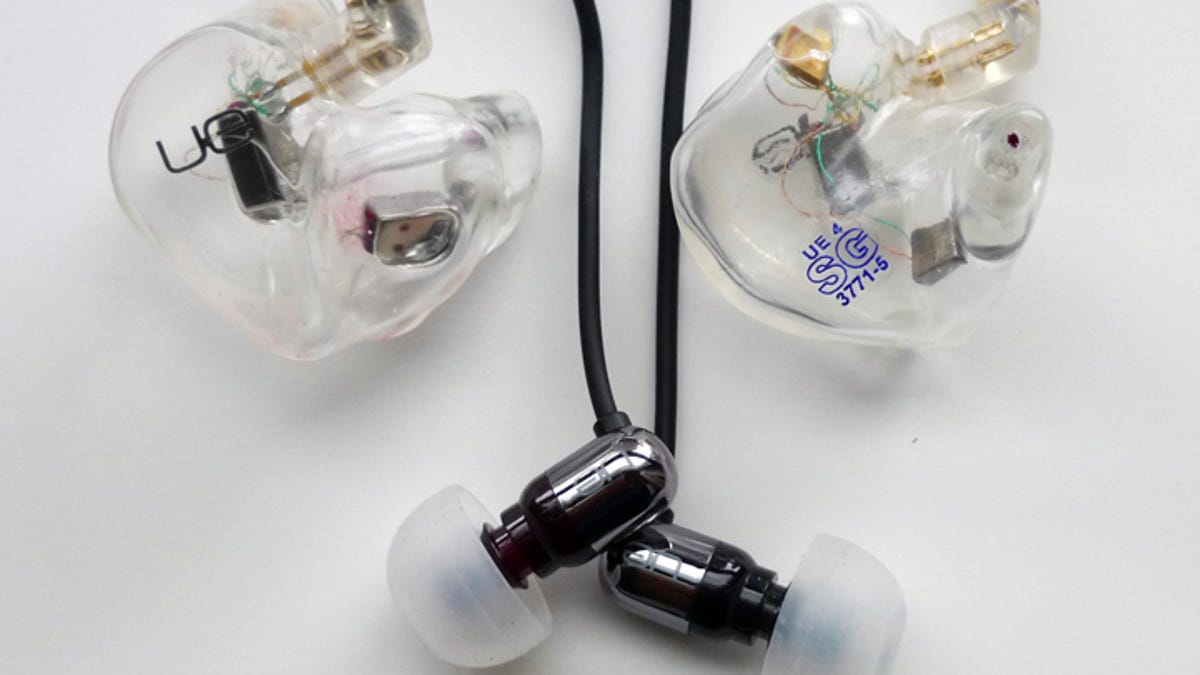Are headphones that are custom-molded to your ears worth it?
Do custom-molded headphones sound better than universal-fit earphones? We compared Ultimate Ears custom UE-4 with the universal UE 700 to find out.

It was probably 10 years ago when I heard my first custom headphones, and I couldn't get over the sound. It was an Ultimate Ears UE-5 model, and the level of detail was so much better than any previous headphones I'd tried. The custom earpieces' superior noise-isolation dividends were also part of the appeal, because as the background noise level goes down, the apparent detail goes up. With less environmental noise overpowering the subtle/quiet details in the music, I could listen at lower volume levels. Once you've experienced what custom-molded headphones can do, it's hard to settle for universal-fit headphones.
The catch is, not only are custom headphones expensive, you also have to visit an audiologist to make impressions of your ear canals. Fees vary, but it's generally around $100. Your headphones' earpieces will be made from those impressions to exactly match your ears.
Regarding the high cost, I think it's more than justified by the fact that each pair of headphones is truly unique and custom-fit to only your ears and are hand-assembled by a Logitech Ultimate Ears technician in Irvine, Calif. The driver elements are pretty special, too; all UE custom headphones feature proprietary balanced armature drivers instead of the usual dynamic drivers, which are more like miniaturized speaker drivers. Balanced armatures produce clearer sound and less distortion than conventional drivers.
I reviewed UE's least expensive custom in-ear model, the UE-4 ($399), in early 2011, and when I started listening to it again I had a bright idea: compare it with Ultimate Ears' universal-fit, dual-armature UE 700 ($150) headphones. That way I could get a better handle on exactly what custom-fitted headphones do better than the equivalent universal model from the same manufacturer. Both headphones have two balanced armature drivers in each earpiece.
Ultimate Ears sent a UE 700 so I could proceed with the test. It comes with five sizes of silicone eartips (XXS, XS, S, M, L) and two sets of Comply foam tips (I used the biggest silicone tips). Remember, if you don't get a proper headphone/ear seal, all bets are off: bass response won't be all it could be, sound isolation will be compromised, and the earpieces won't stay put in your ears. I liked the sound; it was smooth, bass was nicely defined, and midrange and treble detailing were excellent. The UE 700 is also one of the smallest in-ear headphones I've ever used, and that size advantage pays off in comfort, you can easily forget you have headphones on.
Regarding the '700's tiny size, it's easy to see when you compare the two UE headphones side by side that the balanced armature drivers -- the metal boxes visible within the UE-4's clear acrylic earpiece -- are much too large to fit inside the tiny UE 700 earpieces. So not all balanced armature drivers look alike. The UE-4s are higher-quality proprietary units than the smaller ones in the UE 700.
The UE 4 earpieces fit deeper in your ear canals than the UE 700's tips, and bass couples better with deeper insertion. The UE 700 isn't bass-shy, but the UE 4's bass is deeper and more accurate. The same can be said about the midrange and treble; the UE 4 sounds richer overall, and yet the detail is still there. All of those comparisons were done with my iPod Classic, and the sound only got better when I plugged the UE 4 into the ALO Rx-MK3B headphone amplifier and Cypher Labs' AlgoRhythm Solo digital-to-analog converter. These headphones' sound potential is high.
Switching back and forth between the two headphones the differences are far from subtle. The UE 4 is more dynamically alive, and can play louder with an ease the UE 700 can't match. The one area where the UE 700 surpasses the UE 4 is comfort; I'm much more aware of the UE 4s in my ears than the smaller and lighter UE 700s.
Custom in-ear headphones are used by a lot of musicians as onstage monitors, and Aerosmith, Goo Goo Dolls, Mary J. Blige, and Vampire Weekend are Ultimate Ears customers. According to the company, 70+ percent of all UE custom headphones are bought by musicians, the rest are sold to audiophiles. If you listen to headphones when you travel or commute, the UE 4 would be a smart choice for its noise isolation and it sounds way better than any noise-canceling headphone I've tried.
UE offers two years of warranty coverage on the UE 700, but only one year for the UE 4. That seems odd to me, but since the UE 4's cables are user-replaceable, and cables are usually the part that breaks first, you might not have to return the headphones for service. The UE 4's braided cables and connectors look far more durable than the sort you get with most universal-fit headphones, so I wouldn't expect to see cable-related problems with the UE 4.
I'd love to hear from anyone who owns any brand of custom in-ear headphones; tell us about your experiences in the Comments section.

